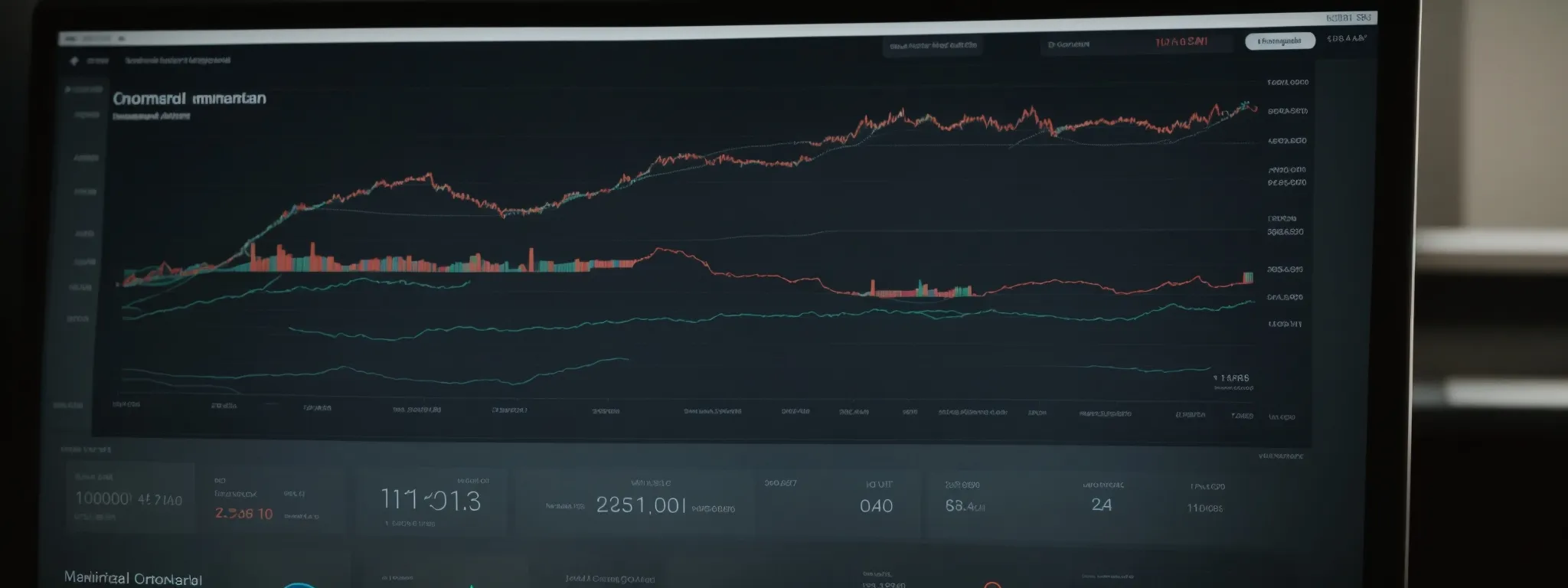Learning SEO: A Beginner’s Journey
Embarking on SEO: Guiding Beginners Through the Basics of Search Engine Optimization Embarking on the intricate dance with search engine algorithms requires a solid grasp of SEO […]
Embarking on SEO: Guiding Beginners Through the Basics of Search Engine Optimization
Embarking on the intricate dance with search engine algorithms requires a solid grasp of SEO fundamentals.
The journey begins with demystifying search engine optimization, a crucial cog in the vast machinery of digital marketing that elevates a brand’s online presence.
LinkGraph’s SEO services shine a light on this digital pathway, offering beginners the expertise necessary to navigate the fundamentals of keyword research, content creation, and the ever-important web of backlinks.
As a primer, this guide positions fledgling marketers to craft strategies that resonate with search engines and audiences alike.
In this article, one discovers the keystones of SEO best practices that promise not just visibility but also the opportunity to lead in the competitive digital arena.
Key Takeaways
- On-Page SEO Concerns the Content and Technical Optimization Within a Website, While Off-Page SEO Builds Credibility With Backlinks.
- LinkGraph’s SEO Services and SearchAtlas SEO Software Offer Comprehensive Keyword Research Tools and Tracking Capabilities
- A Strategic SEO Content Strategy Intertwines Keyword Integration With High-Quality, User-Focused Content
- Regular Backlink Analysis With LinkGraph’s Free Backlink Analysis Tool Is Pivotal in Maintaining a Healthy and Potent Link Profile
- Interpretation of SEO Analytics Is Vital in Adjusting Strategies and Achieving Better Search Engine Rankings and ROI
Understanding the Essence of SEO for Beginners

As professionals in the field assert, understanding the essence of Search Engine Optimization (SEO) is a pivotal component for anyone venturing into the digital marketing landscape.
By grasping the core concepts of SEO, individuals and businesses position themselves to harness the power of online visibility, driving targeted traffic to their web pages.
Distinguishing between on-page and off-page SEO serves as the foundation of a robust SEO content strategy, an indispensable element to amplify a brand’s online presence.
The initiation into this realm imparts knowledge on best practices and equips marketers with the tools needed to navigate the ever-evolving parameters set by search engines.
Grasping the Core Concepts of SEO
Embarking on the journey of SEO commences with the recognition of its dual facets: on-page and off-page optimization. On-page SEO encompasses meticulously crafting content with strategic keyword placement and ensuring that every web page adheres to technical standards, thereby making it more palatable to search engine algorithms.
Conversely, off-page SEO focuses on building credibility and authority through White-Label Link Building Services and nurturing backlinks, which act as endorsements from other reputable domains, signaling to search engines the value and relevance of a site’s content to users’ search queries.
Recognizing the Importance of SEO in Digital Marketing
In the digital arena, SEO emerges as the cornerstone, enabling brands to effectively reach their intended audience. It transcends mere visibility; a well-executed SEO strategy ensures that a company’s marketing efforts are not only seen but resonate with the needs and search behaviors of prospective customers.
The merit of infusing SEO into a digital marketing strategy manifests in the alignment of a company’s online content with the user’s search intent. This intentional congruence catapults a brand’s web pages to the forefront of Google search results, effectively transforming passive searchers into engaged visitors and, ultimately, loyal customers.
Differentiating Between on-Page and Off-Page SEO
At the core of mastering SEO lies the distinction between on-page and off-page optimization: two sides of the same coin, each with unique contributions to a site’s search engine rank. On-page SEO is meticulously executed within the website’s boundaries, focusing on optimizing individual pages so they might fare better with search algorithms through keyword integration, meta tags, and content refinement.
- On-page SEO: Tailoring content and structure within the website to meet search engine criteria.
- Off-page SEO: Strengthening a site’s position through external means like backlinks and social signals.
In contrast, off-page SEO spans beyond the website’s confines, striving to elevate a site’s stature in the digital ecosystem through efforts such as white-label link building services and crafting a network of backlinks. This external strategy serves to bolster a site’s perceived authority and relevance, cornerstones in the architecture of digital trust and search engine success.
Conducting Your First Keyword Research

Commencing a journey in search engine optimization necessitates a strategic approach to keyword research, a crucial step in decoding the language of potential customers and their search behaviors.
Identifying your target audience and aligning business objectives sets the stage for discovering impactful keywords.
By employing tools designed for keyword discovery, businesses unlock insights into the phrases that customers use to find solutions or products.
Moreover, comprehending keyword intent enhances the ability to deliver content that precisely matches the expectations of users, ensuring that a brand’s web page becomes a relevant answer to the queries that prospective clients are actively seeking.
This introductory phase lays the groundwork for an informed SEO strategy that is inherently customer-centric.
Identifying Your Target Audience and Business Goals
Unveiling the contours of one’s target audience is critical, articulating a clear demographic profile that encompasses their behaviors, needs, and preferences. This initial reconnaissance dictates the trajectory of SEO efforts, ensuring every aspect of a marketing strategy echoes the distinct voice of the customer segments a company intends to reach.
Simultaneously, elucidating business objectives within the SEO domain provides a benchmark against which a brand’s digital performance can be measured. Objectives may range from enhancing brand awareness to boosting sales, each requiring tailor-made keyword strategies to propel a web page to prominence in the search engine results page (SERP).
Exploring Tools for Keyword Discovery
To navigate the seas of SEO, one must familiarize oneself with the compasses and maps of the trade—keyword research tools. These instruments are not mere conveniences but necessities, enabling marketers to pinpoint search terms that resonate with their audience.
As a beacon in this venture, LinkGraph’s SEO services include the SearchAtlas SEO software, which stands as a sophisticated keyword research tool. This suite aids in unveiling search volume, keyword difficulty, and aids in unearthing long-tail keywords that often elude less comprehensive tools.
| Feature | Benefit |
|---|---|
| Search Volume Data | Identify popular search queries |
| Keyword Difficulty Assessment | Gauge competition for keywords |
| Long-Tail Keyword Discovery | Access niche phrases for targeted strategy |
| Integration with SEO Strategy | Seamlessly connect findings to overarching goals |
Understanding Keyword Intent for Better Results
The pursuit of optimal keyword intent goes beyond mere identification; it seeks to unravel the underlying motivations driving searchers in their online queries. By incorporating LinkGraph’s SEO services and the capabilities of SearchAtlas SEO software into their strategy, businesses can not only predict but also fulfill the needs that prompt a search, tailoring their content to meet these specific requirements, thus standing out in a crowded digital marketplace.
Appreciating the subtleties of keyword intent equips marketers with the acumen to design a content strategy that aligns seamlessly with the audience’s expectations, fostering heightened engagement and conversion rates. This fine-tuning ensures that every web page crafted serves as a beacon, clearly signaling to the search engines that its content is directly relevant to the searcher’s intent, propelling the brand to a position of authority and influence within Google search results.
Crafting Content That Ranks on Search Engines

Stepping into the arena of search engine optimization requires a tactful balance between crafting for the end user and abiding by the algorithmic intricacies of search engines.
A comprehensive SEO content strategy mandates the creation of material that strikes a chord with the reader while subtly satisfying the metrics search engines utilize for ranking.
Clever integration of keywords within content ensures natural readability, while meta tags and descriptions play a crucial role in signaling the essence of a web page’s content.
This strategic approach to content creation sets the stage for enhanced visibility and user engagement, charting the path for online success.
Writing Content With Both Users and Search Engines in Mind
Adroitly balancing the needs of users with the technical demands of search engines forms the crux of successful SEO-focused content writing. Each web page must resonate with the user, providing clear, concise, and informative content that naturally incorporates targeted keywords, without compromising the fluency and readability that foster user engagement.
Through this harmonious union, LinkGraph’s SEO services place emphasis on the user experience while ensuring that the underlying SEO fundamentals are meticulously adhered to. Implementing such dual-focused content strategies elevates a brand’s narrative, driving enhanced visibility and thus fostering a lasting impact within the digital ecosystem.
Incorporating Keywords Into Your Content Organically
Mastering the art of seamlessly weaving keywords into the tapestry of web content demands precision and subtlety. LinkGraph’s SEO services exemplify the expertise required, embedding targeted search terms into text in a manner that maintains the article’s integrity, while optimizing for search engines.
By fostering natural keyword integration, LinkGraph ensures that each piece of content not only resonates with the audience but also complies with search engine optimization best practices. This holistic approach propels web pages in their climb through the rankings, making them more discoverable to users seeking the information or services they offer.
Utilizing Meta Tags and Descriptions Effectively
Meta tags and descriptions serve as concise summaries that provide search engines with quick insights into the content of a web page. When utilized effectively, they contribute to the page’s visibility and click-through rates, acting as compelling previews that encourage searchers to select one particular result over others.
The strategic placement and crafting of these elements are not arbitrary: they require a marketer’s acumen and precision. Meta descriptions, specifically, should encapsulate the page’s value proposition, utilizing keywords in a natural manner that aligns with the page’s content and the search intent of the user:
| SEO Element | Role in SEO | Best Practices |
|---|---|---|
| Meta Tags | Inform search engines of page content | Accurate representation, no keyword stuffing |
| Meta Descriptions | Influence user click-through rates | Compelling, succinct, keyword-inclusive |
On-Page Optimization Tactics for Beginners

At the advent of mastering search engine optimization, on-page optimization stands as a pivotal step for novices entering the digital arena.
This facet of SEO involves a meticulous focus on enhancing each web page from within, ensuring that elements such as title tags and header hierarchies are optimized to meet search engine standards.
On-page tactics extend further, encompassing the site structure itself, which when refined, greatly improves user experience and navigability.
Additionally, image optimization techniques contribute significantly to page load times and overall performance, essential factors in SEO efficacy.
These foundational techniques equip beginners with the skills necessary to optimize web content effectively and to navigate the subtleties of on-page SEO with confidence.
Mastering Title Tags and Header Hierarchies
For beginners stepping into the realm of on-page SEO, title tags emerge as primary waypoints on the road to optimization: They are the succinct descriptors of a webpage’s content. These tags are not only critical for informing search engines about the subject of a page but also serve as the initial focal point for users in the search engine results page (SERP).
| SEO Element | Purpose | Impact on User Experience |
|---|---|---|
| Title Tags | Convey the main topic of a web page to search engines and users | Immediate clarity and relevance, influencing click-through rates |
| Header Hierarchies (H1, H2, H3, etc.) | Organize content for ease of reading and navigability | Enhanced user engagement through structured and accessible information |
Header hierarchies, encompassing H1 through H3 tags and beyond, act as the blueprint for structuring content in a logically segmented and digestible manner. Not only does a well-defined hierarchy enhance user engagement by making information easily accessible, but it also allows search engines to better understand the relative importance of various topics within the content, thereby strengthening the SEO potential of each web page.
Enhancing User Experience Through Site Structure
For novices, refining a website’s structure is akin to setting a sturdy foundation for a building; it is crucial to ensure that visitors can navigate the digital space with ease. An intuitive site structure not only enhances the user experience but also guides the search engine crawlers, augmenting the clarity with which they index content.
Addressing site architecture involves organizing content into a coherent flow that reflects the user’s journey from entrance to conversion: This pivotal restructuring moves beyond aesthetics, focusing on a systematic, user-friendly approach. The fruits of such labor are twofold: a boost in user satisfaction and a subtle yet significant favor from search engine algorithms:
- A logical layout aids users in finding desired information swiftly, contributing to a reduction in bounce rates.
- Search engines reward sites that facilitate excellent user navigation with better rankings, recognizing their structure as a marker of quality content delivery.
Implementing Image Optimization Techniques
As beginners familiarize themselves with on-page SEO, the importance of image optimization becomes unmistakably clear. Cleverly optimized images can accelerate website performance, enhance user engagement, and contribute to higher search engine rankings by reducing page load times and creating a visual appeal that echoes the textual content.
An effective strategy for image optimization includes selecting the correct file format and compressing images to balance quality and file size. Entrepreneurs and website managers striving for online prominence through LinkGraph’s on-page SEO services quickly recognize that well-optimized images are a subtle, yet critical puzzle piece in the comprehensive picture of search engine optimization.
The Role of Backlinks in SEO Strategy

In the intricate dance of Search Engine Optimization, backlinks emerge as a fundamental step that pioneers in the field must master.
These links are not mere strands connecting one site to another; they serve as a testament to the credibility and authority of a website, thereby playing a decisive role in its SEO success.
As beginners embark on building an online presence, appraising the value of backlinks and discerning methods to acquire them while monitoring their link profile is paramount to evade any penalties from search engines.
Acknowledging the potency of this element in the SEO arsenal aligns fledgling digital marketers with the pathway to transforming their site into a distinguished and trusted node within the vast web network.
What Are Backlinks and Why Are They Crucial?
Backlinks are the cornerstone of off-page SEO, acting as bridges between pages across the digital expanse. They are endorsements, with external sites vouching for the content’s quality and relevance by linking back to it.
The crucial nature of backlinks in SEO cannot be overstated; they substantially affect a website’s ranking in search engine results, therefore dictating its visibility to users. Recognized by search engines as votes of confidence, backlinks help establish a website’s authority, contributing to its credibility and organic search stature:
| SEO Element | Function in SEO | Impact on Website Authority |
|---|---|---|
| Backlinks | Serve as indicators of content credibility and relevance | Higher quantity and quality of backlinks typically lead to increased perceived authority |
Methods to Acquire Quality Backlinks for Your Site
The quest for quality backlinks begins with creating stellar content that naturally encourages sharing and citation among industry peers and authority websites. LinkGraph’s expertly tailored guest posting services serve as a fulcrum in this endeavor, facilitating the placement of a brand’s articles and infographics on relevant and reputable external sites, thereby securing valuable backlinks.
In addition to producing link-worthy material, leveraging strategic relationships offers another avenue for accruing authoritative backlinks. Networking with industry insiders and participating in digital communities can lead to organic growth in backlink profiles as connections mature into opportunities for mutual endorsement and support through LinkGraph’s white-label link building services.
Monitoring Your Link Profile to Avoid Penalties
Vigilance in monitoring one’s link profile is essential to ensure backlinks serve their intended purpose without inadvertently invoking search engine penalties. As such, LinkGraph’s SEO services provide a comprehensive solution through their free backlink analysis, allowing clients to scrutinize the quality and authenticity of their incoming links, thereby circumventing any adverse impacts on their SEO efforts.
Forging ahead in SEO requires recognizing the potential pitfalls associated with backlinks; Google’s algorithms are adept at detecting manipulative or low-quality links. Utilizing LinkGraph’s sophisticated tools, businesses can perform regular audits of their backlink profiles, thus maintaining the integrity of their link-building strategies and safeguarding their positions within Google search results.
Measuring SEO Success With Analytics

Embarking on the journey of search engine optimization offers myriad rewards, yet quantifying the success of such endeavors demands a meticulous approach to tracking and analysis.
Seasoned SEO professionals know that setting up essential tracking tools is the bedrock for insightful analytics, allowing for the distillation of raw data into actionable intelligence.
Understanding how to interpret key metrics in SEO reports provides a deeper comprehension of performance, factors contributing to success or underperformance, and opportunities for optimization.
Armed with these insights, businesses are empowered to make informed decisions, finetuning their strategies to harness the full potential of digital marketing and achieve their objectives in the online domain.
Setting Up Essential SEO Tracking Tools
For professionals delving into the digital terrain, the ability to navigate through the sea of data is tied to the proper implementation of SEO tracking tools. Establishing a robust framework for analytics initiates with the integration of advanced tracking solutions such as SearchAtlas SEO software, enabling businesses to monitor key performance indicators (KPIs) and track their website’s progress in real-time.
Essential tracking tools grant businesses the precision to discern the effectiveness of their SEO strategies: They understand which keywords bolster their SERP rankings, the type of content that engages their audience, and the user behaviors that drive conversions. LinkGraph’s SEO services facilitate this strategic oversight by offering comprehensive tracking facilities that translate complex data into understandable metrics:
| KPIs Monitored | SEO Impact | LinkGraph’s SEO Services Advantage |
|---|---|---|
| Keyword Performance | Identifies ranking strength and opportunity areas | Enables strategic refinement of keyword usage |
| Content Engagement | Indicates user interest and content relevancy | Guides content strategy enhancements for better engagement |
| Conversion Metrics | Assesses the ROI of SEO efforts | Supports tactical adjustments for improved conversion rates |
Interpreting Key Metrics in SEO Reports
Interpreting key metrics in SEO reports requires a discerning eye that LinkGraph’s SEO services have honed to perfection. Through their comprehensive analysis, clients gain clarity on their digital standing, learning to distinguish between the myriad of metrics and the insights they provide—ranging from organic traffic growth to bounce rates and conversion percentages, all serving as indicators of campaign efficacy.
LinkGraph’s seasoned professionals understand that metrics tell a story—each datum provides a piece of the puzzle that is a brand’s online presence. By evaluating the intricacies of user behavior, acquisition channels, and keyword rankings, these experts offer clients a complete picture of performance, driving strategic decisions that elevate a website’s SEO success.
Making Informed Decisions Based on Data Insights
Data-informed decisions stand as the keystone in the archway to SEO prosperity. By meticulously analyzing the insights yielded from SEO reports, businesses can pinpoint the most impactful areas for optimization, making calculated adjustments to enhance their online presence.
LinkGraph’s SEO services transform complex datasets into a strategic road map, guiding clients through the terrain of digital marketing with expert precision. Executives and marketing teams leverage these data insights to steer their SEO initiatives toward achieving higher rankings, increased traffic, and ultimately, a greater return on investment.
| SEO Metric | Interpretation | Strategic Action |
|---|---|---|
| Organic Traffic Growth | Assessment of audience reach expansion | Optimization of content and keyword targeting |
| Bounce Rates | Evaluation of content relevancy and user engagement | Enhancement of user experience and on-page elements |
| Conversion Percentages | Measurement of the effectiveness of conversion funnels | Refinement of calls to action and user journey pathways |
Conclusion
Embarking on the SEO journey equips beginners with the essential knowledge to enhance their online presence and drive targeted traffic to their websites.
With a solid understanding of on-page and off-page SEO, identifying impactful keywords, and creating content that satisfies both user needs and search engine algorithms, businesses can significantly improve their digital visibility.
By mastering backlink strategies to establish credibility and employing analytics to track performance, beginners in SEO can make data-driven decisions to optimize their strategies.
This foundational knowledge is critical for anyone looking to succeed in the competitive world of digital marketing.














































































